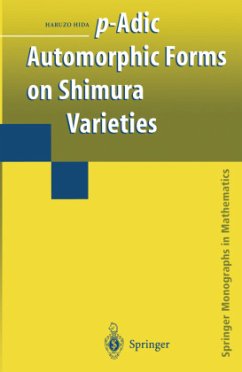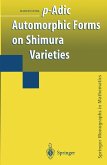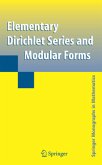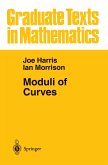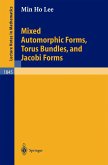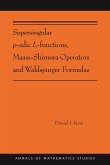In the early years of the 1980s, while I was visiting the Institute for Ad vanced Study (lAS) at Princeton as a postdoctoral member, I got a fascinating view, studying congruence modulo a prime among elliptic modular forms, that an automorphic L-function of a given algebraic group G should have a canon ical p-adic counterpart of several variables. I immediately decided to find out the reason behind this phenomenon and to develop the theory of ordinary p-adic automorphic forms, allocating 10 to 15 years from that point, putting off the intended arithmetic study of Shimura varieties via L-functions and Eisenstein series (for which I visited lAS). Although it took more than 15 years, we now know (at least conjecturally) the exact number of variables for a given G, and it has been shown that this is a universal phenomenon valid for holomorphic automorphic forms on Shimura varieties and also for more general (nonholomorphic) cohomological automorphic forms on automorphic manifolds (ina markedly different way). When I was asked to give a series of lectures in the Automorphic Semester in the year 2000 at the Emile Borel Center (Centre Emile Borel) at the Poincare Institute in Paris, I chose to give an exposition of the theory of p-adic (ordinary) families of such automorphic forms p-adic analytically de pending on their weights, and this book is the outgrowth of the lectures given there.
From the reviews:
"Hida views ... the study of the geometric Galois group of the Shimura tower, as a geometric reciprocity law ... . general goal of the book is to incorporate Shimura's reciprocity law in a broader scheme of integral reciprocity laws which includes Iwasawa theory in its scope. ... a beautiful and very useful reference for anybody interested in the arithmetic theory of automorphic forms." (Jacques Tilouine, Mathematical Reviews, 2005e)
"The first purpose of this book is to supply the base of the construction of the Shimura variety. The second one is to introduce integrality of automorphic forms on such varieties ... . The mathematics discussed here is wonderful but highly nontrivial. ... The book will certainly be useful to graduate students and researchers entering this beautiful and difficult area of research." (Andrzej Dabrowski, Zentralblatt MATH, Vol. 1055, 2005)
"The purpose of this book is twofold: First to establish a p-adic deformationtheory of automorphic forms on Shimura varieties; this is recent work of the author. Second, to explain some of the necessary background, in particular the theory of moduli and Shimura varieties of PEL type ... . The book requires some familiarity with algebraic number theory and algebraic geometry (schemes) but is rather complete in the details. Thus, it may also serve as an introduction to Shimura varieties as well as their deformation theory." (J. Mahnkopf, Monatshefte für Mathematik, Vol. 146 (4), 2005)
"The idea is to study the 'p-adic variation' of automorphic forms. ... This book ... is a high-level exposition of the theory for automorphic forms on Shimura Varieties. It includes a discussion of the special cases of elliptic modular forms and Hilbert modular forms, so it will be a useful resource for those wanting to learn the subject. The exposition is very dense, however, and the prerequisites are extensive. Overall, this is a book I am happy to have on my shelves ... ." (Fernando Q. Gouvêa, Math DL, January, 2004)
"Hida ... showed that ordinary p-adic modular forms moved naturally in p-adic families. ... In the book under review ... Hida has returned to the geometric construction of p-adic families of ordinary forms. ... Hida's theory has had many applications in the theory of classical modular forms, and as mathematics continues to mature, this more general theory will no doubt have similarly striking applications in the theory of automorphic forms." (K. Buzzard, Jahresbericht der Deutschen Mathematiker-Vereinigung, Vol. 109 (4), 2007)
"Hida views ... the study of the geometric Galois group of the Shimura tower, as a geometric reciprocity law ... . general goal of the book is to incorporate Shimura's reciprocity law in a broader scheme of integral reciprocity laws which includes Iwasawa theory in its scope. ... a beautiful and very useful reference for anybody interested in the arithmetic theory of automorphic forms." (Jacques Tilouine, Mathematical Reviews, 2005e)
"The first purpose of this book is to supply the base of the construction of the Shimura variety. The second one is to introduce integrality of automorphic forms on such varieties ... . The mathematics discussed here is wonderful but highly nontrivial. ... The book will certainly be useful to graduate students and researchers entering this beautiful and difficult area of research." (Andrzej Dabrowski, Zentralblatt MATH, Vol. 1055, 2005)
"The purpose of this book is twofold: First to establish a p-adic deformationtheory of automorphic forms on Shimura varieties; this is recent work of the author. Second, to explain some of the necessary background, in particular the theory of moduli and Shimura varieties of PEL type ... . The book requires some familiarity with algebraic number theory and algebraic geometry (schemes) but is rather complete in the details. Thus, it may also serve as an introduction to Shimura varieties as well as their deformation theory." (J. Mahnkopf, Monatshefte für Mathematik, Vol. 146 (4), 2005)
"The idea is to study the 'p-adic variation' of automorphic forms. ... This book ... is a high-level exposition of the theory for automorphic forms on Shimura Varieties. It includes a discussion of the special cases of elliptic modular forms and Hilbert modular forms, so it will be a useful resource for those wanting to learn the subject. The exposition is very dense, however, and the prerequisites are extensive. Overall, this is a book I am happy to have on my shelves ... ." (Fernando Q. Gouvêa, Math DL, January, 2004)
"Hida ... showed that ordinary p-adic modular forms moved naturally in p-adic families. ... In the book under review ... Hida has returned to the geometric construction of p-adic families of ordinary forms. ... Hida's theory has had many applications in the theory of classical modular forms, and as mathematics continues to mature, this more general theory will no doubt have similarly striking applications in the theory of automorphic forms." (K. Buzzard, Jahresbericht der Deutschen Mathematiker-Vereinigung, Vol. 109 (4), 2007)

